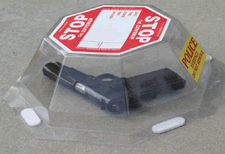Home | Glossary | Resources | Help | Contact Us | Course Map
Archival Notice
This is an archive page that is no longer being updated. It may contain outdated information and links may no longer function as originally intended.
Preservation and Packaging
Evidence (from the scene or other location) must be securely and appropriately packaged. Packaging material that securely contains the evidence protects against loss and contamination. The area of interest should be protected on larger items that cannot be packaged and transported easily (e.g., a door or piece of furniture).
Plastic containers are generally useful for packaging evidence because they can be sealed closed and permit observation of the contents. However, they must not be used for packaging of biological evidence. Biological evidence, such as blood-stained clothing or vegetation suspected to be cannabis, should be packaged in paper containers that allow airflow around the material. Plastic is not recommended for packaging firearms evidence since any moisture present could promote rusting of the item.
No two investigations or sets of physical evidence are the same. The type of evidence and established protocols dictate the packaging and delivery or shipment method.
Firearms and Fired Ammunition Components
Fired ammunition components, such as cartridge cases, bullets, and shotshell cases, may be shipped by registered mail using the United States Postal Service (USPS). The same is true for firearms sent between law enforcement agencies and government-supported forensic laboratories. In view of chain of custody requirements, all fired ammunition components and firearms evidence shipped by registered mail must require a signature for receipt.
Unfired Ammunition
All evidence, including unfired ammunition, is typically hand carried to the laboratory. If the delivery to the laboratory requires the shipping of evidence, the USPS will not ship unfired ammunition due to its potentially dangerous nature, requiring the use of private carriers, including the United Parcel Service (UPS) and FedEx Kinkos, among others.
To comply with United States Department of Transportation (DOT) regulations, each private carrier has specific hazardous material packaging, labeling, and invoice requirements. Regardless of the fact that the shipper is a law enforcement agency or government-supported forensic laboratory, these requirements must be followed. Ultimately, it is the responsibility of the agency to ensure that evidence is shipped correctly, while complying with both the government and the shippers current regulations.
Due to the special handling and tracking required, the shipment of unfired ammunition by private carrier most often results in additional costs. It is usually more cost-effective to ship a small amount of live ammunition by private carrier, forwarding the bulk of the evidence by other means. Laboratories must have administrative protocols in place to accommodate relating a shipment(s) to a particular case and examiner, through the requirement that an invoice is attached to the exterior of each package.
Additional Online Courses
- What Every First Responding Officer Should Know About DNA Evidence
- Collecting DNA Evidence at Property Crime Scenes
- DNA – A Prosecutor’s Practice Notebook
- Crime Scene and DNA Basics
- Laboratory Safety Programs
- DNA Amplification
- Population Genetics and Statistics
- Non-STR DNA Markers: SNPs, Y-STRs, LCN and mtDNA
- Firearms Examiner Training
- Forensic DNA Education for Law Enforcement Decisionmakers
- What Every Investigator and Evidence Technician Should Know About DNA Evidence
- Principles of Forensic DNA for Officers of the Court
- Law 101: Legal Guide for the Forensic Expert
- Laboratory Orientation and Testing of Body Fluids and Tissues
- DNA Extraction and Quantitation
- STR Data Analysis and Interpretation
- Communication Skills, Report Writing, and Courtroom Testimony
- Español for Law Enforcement
- Amplified DNA Product Separation for Forensic Analysts



